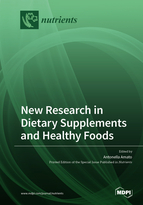New Research in Dietary Supplements and Healthy Foods
A special issue of Nutrients (ISSN 2072-6643). This special issue belongs to the section "Phytochemicals and Human Health".
Deadline for manuscript submissions: closed (31 December 2020) | Viewed by 92674
Special Issue Editor
Interests: obesity; high fat diet; glucose dysmetabolism; dyslipidemia; obesity-related neurodegeneration; functional foods; dietary supplements
Special Issues, Collections and Topics in MDPI journals
Special Issue Information
Dear Colleagues,
Nutrients is planning a Special Issue on the roles of natural bioactive compounds contained in dietary supplements and functional foods in the maintenance of a good health status. Usually, bioactive compounds underlying the health-related effects of functional foods and dietary supplements consumption have strong antioxidant activity. As oxidative stress and inflammation are considered the major triggering factors in chronic disease development, the chronic intake of natural bioactive compounds could be considered a useful tool to prevent and/or treat chronic diseases such as cardiovascular diseases, obesity and related comorbidities, neurodegeneration, and cancer. Moreover, the molecular mechanisms by which these beneficial compounds exert their beneficial effects require further study.
Authors are invited to submit proposals for manuscripts that fit the objectives and topics of this Special Issue. In particular, manuscripts presenting basic, applied, and clinical research; observational and meta-analysis studies; and analytical reviews on the beneficial roles of natural bioactive compounds in dietary supplements and healthy foods are encouraged.
Dr. Antonella Amato
Guest Editor
Manuscript Submission Information
Manuscripts should be submitted online at www.mdpi.com by registering and logging in to this website. Once you are registered, click here to go to the submission form. Manuscripts can be submitted until the deadline. All submissions that pass pre-check are peer-reviewed. Accepted papers will be published continuously in the journal (as soon as accepted) and will be listed together on the special issue website. Research articles, review articles as well as short communications are invited. For planned papers, a title and short abstract (about 100 words) can be sent to the Editorial Office for announcement on this website.
Submitted manuscripts should not have been published previously, nor be under consideration for publication elsewhere (except conference proceedings papers). All manuscripts are thoroughly refereed through a single-blind peer-review process. A guide for authors and other relevant information for submission of manuscripts is available on the Instructions for Authors page. Nutrients is an international peer-reviewed open access semimonthly journal published by MDPI.
Please visit the Instructions for Authors page before submitting a manuscript. The Article Processing Charge (APC) for publication in this open access journal is 2900 CHF (Swiss Francs). Submitted papers should be well formatted and use good English. Authors may use MDPI's English editing service prior to publication or during author revisions.
Keywords
- dietary supplements
- natural bioactive compounds
- functional foods
- antioxidant activity
- chronic degenerative disease







